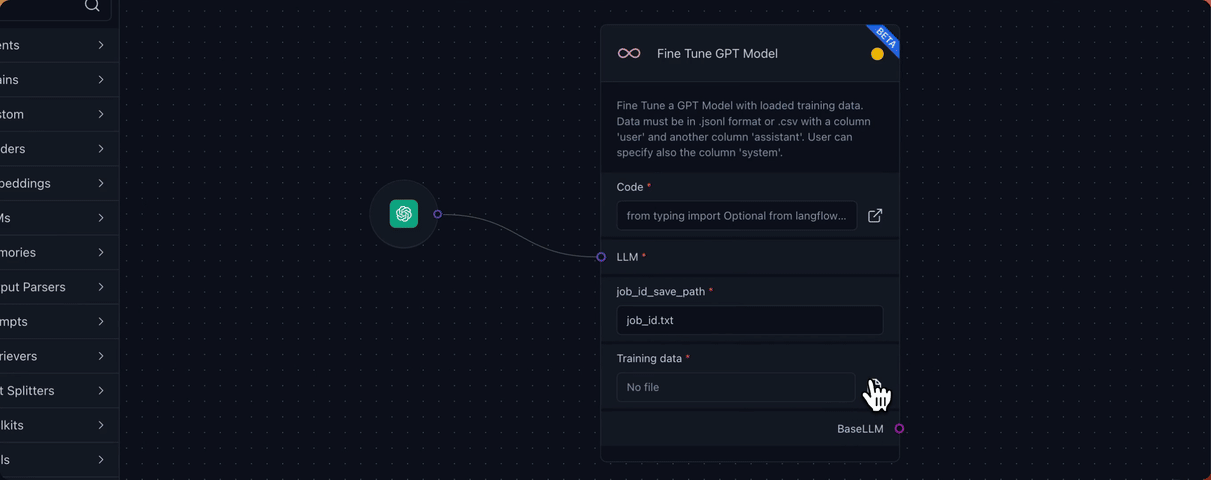 AI
AI
 AI
AI
 AI
AI
DataStax Inc. has taken another big step forward in its bid to become the database of choice for generative artificial intelligence developers, revealing today that it’s buying a startup called Logspace, creator of Langflow, a popular open-source visual framework for building retrieval-augmented generation or RAG applications.
The acquisition represents a major milestone for DataStax, as it forges ahead with its mission of empowering developers with the tools they need to build cutting-edge applications that can take advantage of the latest capabilities of generative AI.
The Langflow platform has gotten a lot of interest in the AI development community because of the way it simplifies the development of RAG applications, which are critical for enhancing the relevance and accuracy of generative AI. By integrating Langflow’s technology with its database service, DataStax is aiming to provide customers with a user-friendly solution for designing and deploying generative AI applications that can scale.
In an interview with TechCrunch, DataStax Chairman and Chief Executive Chet Kapoor said the acquisition will provide developers with the additional resources they need to build applications that can match the scale of their ambitions. “Langflow is focused on democratizing and accelerating generative AI development for any developer or company, and in joining DataStax, we’re working together to enable developers to put their wild new generative AI ideas on a fast path to production,” he said.
DataStax is buying Langflow at a pivotal moment, at a time when enterprises are racing to try and integrate generative AI. The technology’s transformative potential has been widely recognized, and companies know that whoever can implement it successfully first will gain a significant competitive advantage. But the technical challenges of creating generative AI applications has been a stumbling block for many organizations. Developers are forced to use multiple tools, experiment with everything, and all the while they’re being pressured to deliver new apps and features as soon as possible.
Langflow’s platform simplifies the task of building generative AI applications, providing pre-built components that users can drag and drop into place to create an app in just a few minutes, as opposed to hours or weeks. It’s a more intuitive, visual user interface that simplifies the creation of AI workflows.

In a blog post, DataStax’s head of developer relations Carter Rabasa explained that Langflow is the solution developers have been looking for: “Langflow is a new way of building AI apps built on top of LangChain that integrates with the full breadth of the new AI programming stack,” he wrote. “Its interface enables rapid experimentation, testing, and iteration, and its ease of use has opened up AI to a whole new class of developers who have made Langflow one of the fastest growing communities in open source.”
DataStax’s decision to acquire Langflow is a strategic move. By combining Langflow’s intuitive app-building tools with its own, enterprise-grade database capabilities, it is hoping to position itself as a dominant platform for generative AI builders. The company has already pivoted its own database to support generative AI. In July, it integrated vector search capabilities into its database to support the unstructured data AI algorithms need, and in November it launched an “out-of-the-box RAG solution” called RAGStack.
By adding Langflow’s platform into the mix, DataStax is better placed to help enterprises elevate their generative AI strategies and quickly build more powerful applications that can analyze, interpret and generate content, informed by their own data. In this way, it said, it will help to usher in a new era, where business decision-making is informed by data-driven intelligence.
The acquisition also acknowledges a broader trend within enterprise AI, where low-code and no-code platforms have become increasingly popular as a way to enable non-technical users to participate in application development.
Constellation Research Inc. analyst Doug Henschen told InfoWorld that DataStax is likely hoping to leverage Langflow to gain an edge over rivals such as MongoDB Inc. and Azure Cosmos DB, which have both recently announced support for vector search and RAG. “It usually takes time to add such capabilities and gain adoption, so I suspect the Langflow acquisition is all about acceleration while AI interest is high,” he said.
DataStax said the Langflow team will continue to operate independently going forward, though there will obviously be much closer collaboration between the two teams.
Ed Anuff, chief product officer of DataStax, appeared on SiliconANGLE Media’s mobile livestreaming studio theCUBE in December to discuss the company’s ambitions to catalyze the next wave of AI innovation by helping enterprises seamlessly integrate their business data with the most powerful AI applications:
Support our open free content by sharing and engaging with our content and community.
Where Technology Leaders Connect, Share Intelligence & Create Opportunities
SiliconANGLE Media is a recognized leader in digital media innovation serving innovative audiences and brands, bringing together cutting-edge technology, influential content, strategic insights and real-time audience engagement. As the parent company of SiliconANGLE, theCUBE Network, theCUBE Research, CUBE365, theCUBE AI and theCUBE SuperStudios — such as those established in Silicon Valley and the New York Stock Exchange (NYSE) — SiliconANGLE Media operates at the intersection of media, technology, and AI. .
Founded by tech visionaries John Furrier and Dave Vellante, SiliconANGLE Media has built a powerful ecosystem of industry-leading digital media brands, with a reach of 15+ million elite tech professionals. The company’s new, proprietary theCUBE AI Video cloud is breaking ground in audience interaction, leveraging theCUBEai.com neural network to help technology companies make data-driven decisions and stay at the forefront of industry conversations.